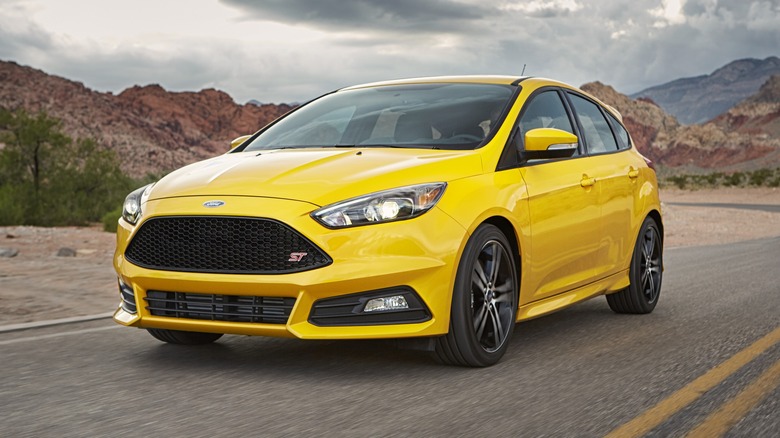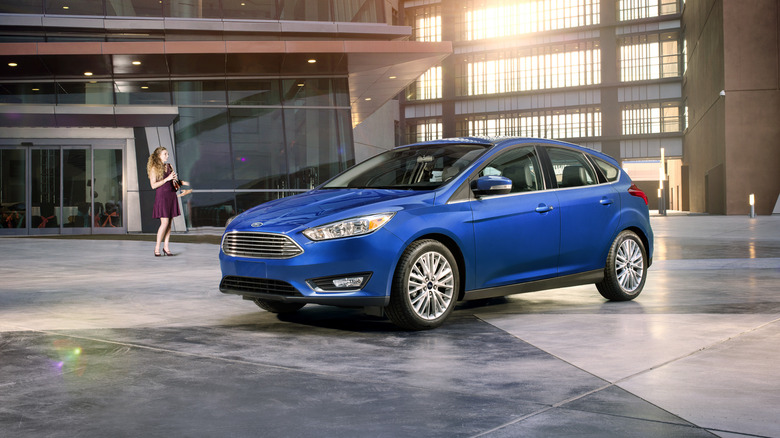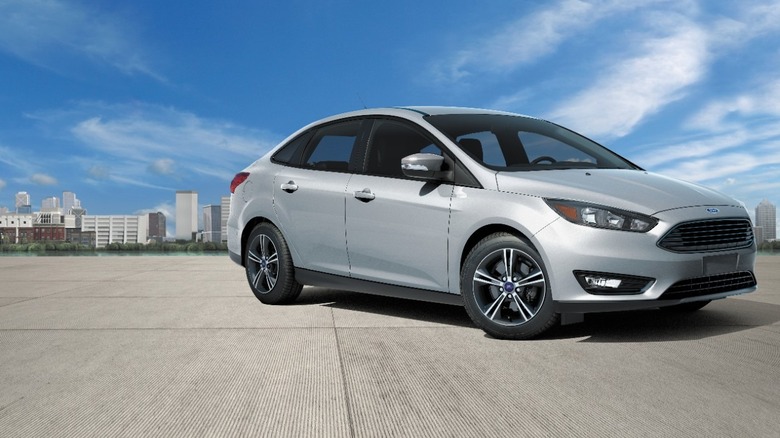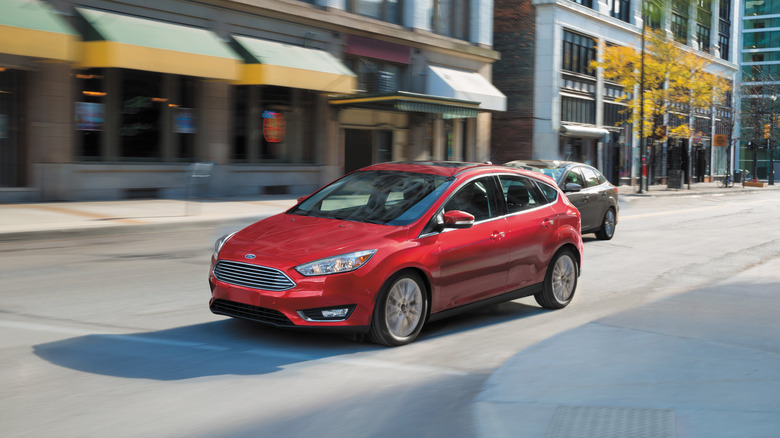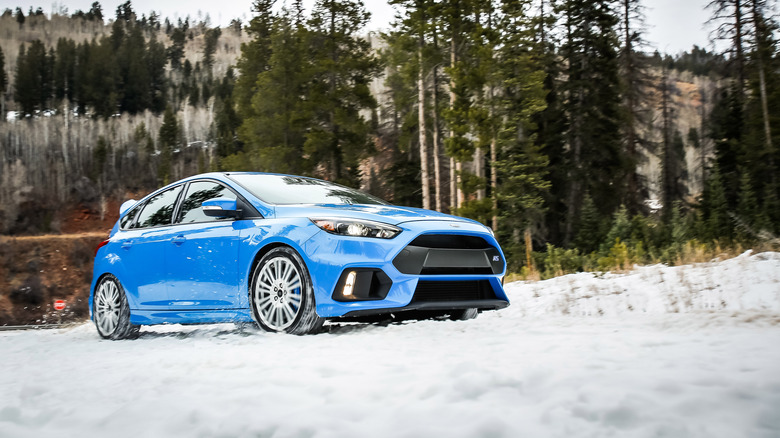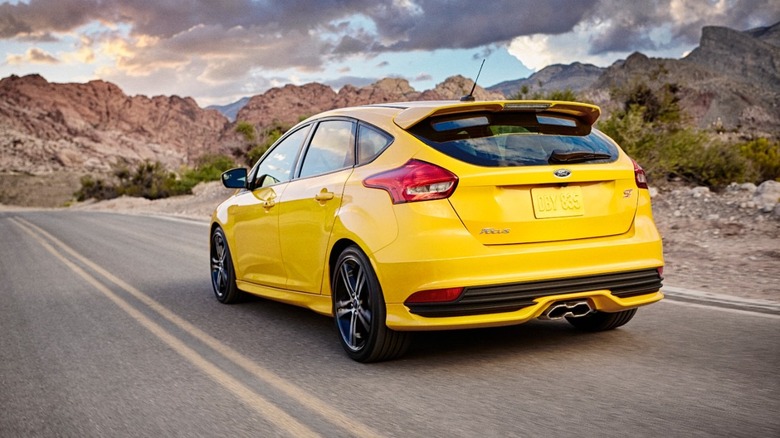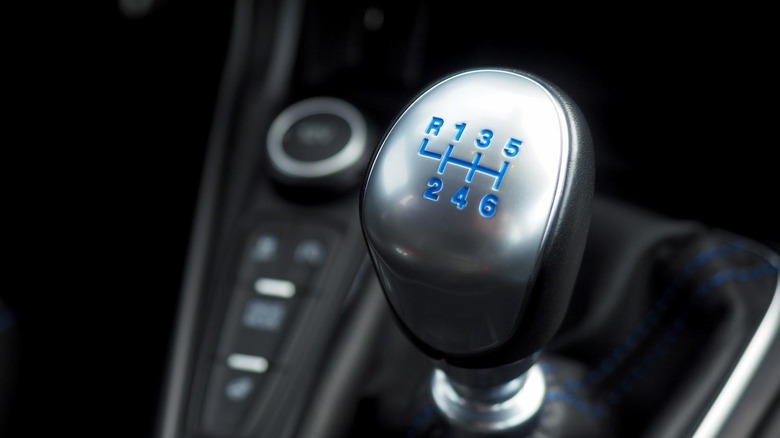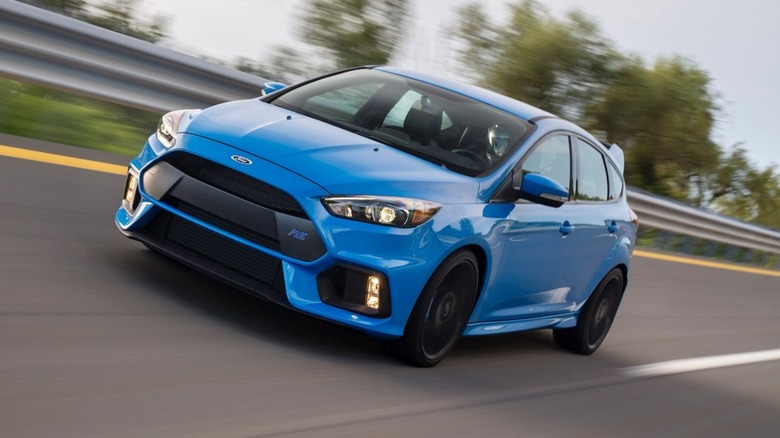8 Reasons To Consider A Used Ford Focus For Your Next Car
News of the Ford Focus' demise was met with dismay by the compact car's many fans, with the long running model axed to free up space in Ford's lineup for more crossovers and electric vehicles. The Focus had been in production since 1998, and for many years was a consistent bestseller for Ford. According to data from R.L. Polk, it was even the best selling car in the world in 2011 and 2012. However, in recent years consumers have tended to favor larger, higher riding crossovers and SUVs, and so sales have slipped considerably from that all-time peak.
It might no longer be possible to order a new Focus from a Ford dealership, but there are a number of reasons why the car might be a good used pick for buyers. Different Focus variants have something to offer for a wide range of drivers, from those looking for an enthusiast-friendly hot hatch to those preferring an economical daily commuter. Here are the top reasons you consider a used Focus for your next vehicle.
The Focus is an affordable used pick
Aside from its top-spec RS variant, the Focus was always an affordable car when new, and that affordability remains the same in the used market. Exact resale prices will vary based on age, condition, and mileage, but using the 2018 Ford Focus as a baseline is a great way to illustrate the car's solid value for the money.
According to KBB, a base-spec 2018 Focus S sedan has a fair purchase price of $7,498 as of this writing, down from an original MSRP of $19,920. Higher up the trim range, the 2018 Focus ST hatchback sports a fair price of $15,942, with an original MSRP of $26,540. Depreciation has remained fairly consistent across the whole Focus range, and with so many examples on the market, buyers can afford to be fussy with price and condition.
Thousands of examples can be found on leading used car listing sites, making it easier to compare any locally-listed examples on factors like value and condition. With such a wide range of examples on offer, buyers also have the choice of prioritizing the factors that suit them — for example, picking a newer model, lower mileage, or lower priced example.
It comes in both sedan and hatchback form
More choice is nearly always a good thing, and used Ford Focus buyers have more choice than buyers of most affordable compact cars. The first decision will be to choose between a Focus hatchback and a sedan, with the two body styles sharing most trim levels aside from top-spec trims like the RS. The sedan body style is best for buyers prioritizing a more traditional looking family car, or those seeking the very cheapest trims, as the base-spec S trim was only available in sedan form.
The hatchback is arguably the better choice for everyone else, offering superior cargo room, easier access, and a more athletic appearance. Both hatchbacks and sedans are losing ground in the new car market as buyers switch to crossovers en masse, with the former category in particular becoming an increasingly rare sight. There's no crossover option available — at least, not in America, as the Focus Active never made it stateside – although anyone looking for a similarly sized crossover might want to consider the Ford Escape.
Maintenance costs are reasonable
The Focus is a bit of a mixed bag when it comes to reliability. The model has suffered a higher than average number of recalls concerning a wide variety of faults, from engine issues to the doors opening while driving. According to RepairPal, the average annual repair cost for a Focus is $569 — for comparison, the Toyota Corolla costs just $362 annually on average. So, the Focus' repair costs are a ways from being the lowest in class, but they're still reasonable even if they're not excellent.
To ensure that any used Focus will be as reliable as possible, it's always a good idea to prioritize condition, ideally picking a car with a full or at least partial service history. Given the high amount of recalls the Focus has suffered over the years, it's also worth checking through the NHTSA's recall portal to see which recalls affect the particular model year of Focus you're considering. Then, check for evidence that any used cars have had the proper remedial work carried out.
It boasts impressive efficiency figures
While it might not be the cheapest car to maintain, the Focus should at least save money at the gas pump. Fuel economy figures vary by trim and model year, with the 2018 Focus achieving an EPA rating of 34 mpg combined in its most frugal form. That will mean settling for the 1.0L three-cylinder engine in manual guise — opting for an auto 'box reduces that combined figure down to 31 mpg.
Buyers of the 2.0L four-cylinder trims should expect combined mpg of between 28 and 31 mpg depending on configuration, while in sportier ST form, the Focus gets a still commendable 25 mpg combined. The Focus RS is both the most potent and the most fuel-hungry of the bunch, achieving an EPA-rated average of 22 mpg, although buyers looking to make the most of its performance prowess will likely see significantly lower figures.
An electric variant of the Focus was also offered, but with a significantly higher MSRP and limited 115 mile range at launch, it's not a car that will appeal to the majority of buyers looking for a used Focus. Naturally, it's the greenest variant of the Focus by far, with an EPA-estimated 107 mpge combined.
The Focus RS is a great hot hatch
For those with a suitably healthy budget, the Ford Focus RS retains the practicality of the regular Focus but dials the fun factor up to maximum. Its 350 horsepower engine is enough to make the car thrillingly fast at full throttle, but it retains decent road manners at everyday speeds too. There are some caveats: SlashGear's tester found the track suspension settings to be mostly redundant for anyone looking to spend most of their time on the road, since the RS' suspension was already harsh enough on regular asphalt without the need for further stiffening.
Drift mode is also a fun but potentially risky mode to engage anywhere that isn't an enclosed circuit. Still, it's a fun addition to have, even if most drivers will barely ever use it. The key appeal for hot hatches like the Focus RS is that they're still practical despite their performance enhancements, and so can be used to get groceries or do the school run just as easily as they can be used to carve up mountain backroads. However, their higher resale price puts them out of reach of the majority of used Focus buyers.
The Focus ST offers more practical driving thrills
If a Focus RS is out of the budget, then the Focus ST is a more affordable compromise that still offers plenty of driving fun. It's not the fastest ST model in the Ford range, only beating the pint-sized Fiesta ST off the line, but its 252 horsepower is still a significant step up from lesser trims. Much like the Focus RS, the Focus ST is at its most enjoyable when driven hard, and so most previous owners will have done exactly that.
That makes proper maintenance doubly important, with service history a must-have for anyone looking for a reliable used example. SlashGear's rundown of the best used car buying tips is a great place to start for anyone looking for common pitfalls to avoid, with the key warning signs including poor tire condition and suspiciously low mileage. While it pays to be careful, anyone who can find a clean, well-maintained example of the Focus ST at a reasonable price will have a great drivers' car on their hands, without the shouty presence and higher upfront cost of the Focus RS.
A manual transmission is available
Manuals are becoming increasingly rare on affordable cars, but the Focus continued to offer one right up until it was axed in North America. While a base-spec Focus transmission isn't going to be a substitute for a true enthusiasts' car, it's still a solid option for either learning to drive stick or just adding a bit of extra engagement to everyday driving. Those looking for maximum driver enjoyment — and, consequently, the best manual 'box the Focus has to offer — should head straight for the Focus RS if their budget allows.
While a stick shift was offered throughout the Focus' production run, most buyers chose to opt for an automatic transmission, and so finding one might be a little trickier than finding an auto. One leading resale site lists only 600 or so manual Focuses compared to more than 3,000 automatic examples at the time of writing.
Its styling has aged well
Styling is always a subjective matter, but the Focus' looks have arguably aged better than many other cars its age, especially in hatchback form. Compared to, for example, the Honda Civic of the same vintage, the Focus looks the more athletic car, exuding a certain sense of driver fun even if some lower-spec trims don't necessarily reflect that in the way that they drive.
In top-spec RS form, the Focus is even sharper looking, with its chunky rear wing, painted calipers, and gaping grille looking suitably sporty without veering too much into teen racer territory. For the majority of budget-oriented buyers, for whom a Focus RS is off the cards, it's safe to say that looks are never going to be the most important factor. Practicality and efficiency have to come first, but having something that doesn't look like either a bland rental or look noticeably dated is always a bonus. The Focus does neither, adding an extra layer of appeal to what's already a solid used car pick.
